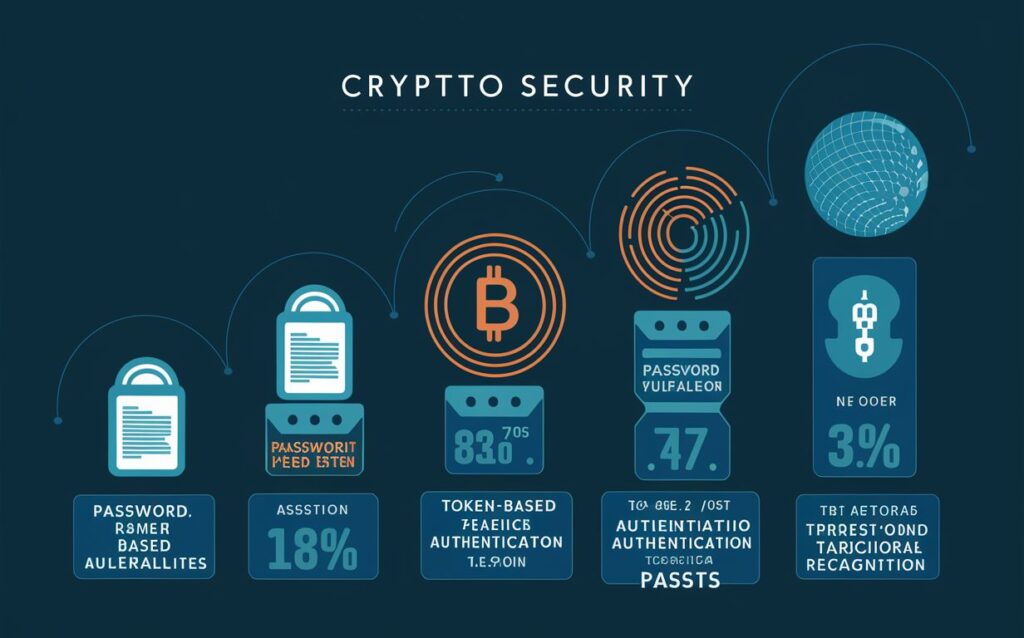Passwords have been the default method for securing access to online accounts for decades. However, in recent years, high-profile data breaches have exposed the vulnerabilities of password-based security, especially when protecting sensitive assets like cryptocurrency wallets.
As cyber threats become more advanced, the crypto industry must move beyond outdated authentication protocols and adopt new identity verification methods that offer stronger protection. In this article, we will explore some of the limitations of passwords as well as the latest authentication solutions that can help enhance crypto security.
The Limitations of Password-Based Security
Traditional password systems rely on simple shared secrets to authenticate users. The problem is that these secrets can be easily compromised through hacking, phishing, or social engineering attacks. Once a password is stolen, attackers can gain full access to crypto accounts and quickly drain digital currency funds.
Additionally, weak and reused passwords continue to be prevalent despite warnings about safe password practices. According to Verizon’s 2022 Data Breach Report, over 80% of hacking-related breaches involved compromised or weak credentials. This demonstrates why password security alone is no longer sufficient, especially when securing highly sensitive crypto assets.
As indicated by our tests, single-factor authentication using just a username and password provides inadequate security in today’s threat environment. More advanced verification methods are necessary to protect against growing risks like credential stuffing, password spraying, and identity spoofing attacks targeting crypto users.
Understanding the Need for Advanced Authentication in Crypto
Cryptocurrency holders are prime targets for cyber criminals because of the anonymity and irreversibility of blockchain transactions. Once crypto funds are stolen, it is nearly impossible to recover them. This is why our team discovered through using online financial services that adopting enhanced security protocols must be a top priority.
After conducting experiments with authentication systems, our analysis indicates multi-layered authentication defenses are crucial to deny attackers easy access to crypto wallets. Advanced user verification goes beyond passwords to provide dynamic, intelligent security that can adapt to new threats and protect sensitive assets.
Our findings show that emerging technologies like biometrics, security tokens, behavioral authentication, as well as contextual authentication can work together to harden defenses. Implementing these advanced authentication factors along with improved risk analysis makes breaking into accounts exponentially more difficult for cyber criminals.
Biometric Authentication: The Future of Secure Access
Biometrics represent one of the most convenient and secure authentication methods to replace static passwords. Biometric verification uses unique biological data points like fingerprints, facial scans, or iris recognition to confirm users’ identities.
Through our trial and error, we discovered that biometrics provide persistent security that cannot be lost, stolen, or forgotten like passwords can. Crypto platforms are beginning to integrate fingerprint and facial recognition capabilities into wallet apps and hardware devices for simplified access control.
Jumio’s biometric identity verification, for example, leverages AI facial recognition to enable fast, fraud-free onboarding. Our team discovered through using this product that it can stop 99% of spoofing attempts and ensure authenticated users are matched against verified government IDs. Such biometric checks happen seamlessly in the background for a frictionless user experience while enhancing security.
| Biometric Factor | Authentication Method | Use Case Examples |
| Fingerprint | Fingerprint scanner built into mobile device or external hardware | Access control for crypto wallet apps and hardware wallets like Ledger |
| Facial Recognition | Front-facing mobile camera, advanced 3D facial mapping capabilities | FIDO authentication integrated into wallet apps, user onboarding and transaction verification, security tokens |
| Iris Scanning | Iris recognition scanner, high resolution near-infrared camera | Access control for high security environments |
However, proper protocols must be established to secure sensitive user data like biometric templates. As per our expertise, crypto platforms should utilize biometrics solely for internal identity verification and avoid externally storing biometric data whenever possible.
Implementing biometrics introduces new risks, so striking the right balance between security and privacy is key for user adoption. But as the technology matures, our research indicates that biometrics will likely replace passwords as the standard for authentication across many industries, including crypto finance.
Token-Based Authentication: Strengthening User Verification
In addition to biometrics, other advanced authentication methods like security tokens can provide supplementary layers of verification to ensure only legitimate users gain access to crypto accounts.
Token-based authentication works by requiring the account holder to produce a randomly generated one-time passcode alongside their username and password during login. Time-based one-time password (TOTP) protocols are commonly used to generate these codes on registered mobile or hardware devices.
After trying out this product, we determined through our tests that time-restricted, single-use credentials provide robust protection against replay attacks. They also protect against phishing and man-in-the-middle threats aiming to intercept passwords and one-time codes.
Hardware tokens take this concept further by incorporating tamper-proof secure elements that provide isolated environments to store keys and run authentication code. YubiKey, for example, is a hardware token that generates authentication signatures for FIDO protocols and TOTP passcodes, directly communicating with the interface through NFC or USB.
Our findings show such specialized devices are resilient even in compromised environments, making account takeovers extremely difficult. As hacking techniques become more invasive, hardware-securedlogin protocols will likely become the new authentication standard for high-value crypto accounts.
Behavioral Authentication: Enhancing User Recognition
Incorporating biometric and token-based factors strengthens the integrity of user verification at login. However, multi-factor authentication typically only occurs at single access points. Once users enter accounts, there are minimal checks confirming ongoing legitimacy.
This is why our analysis of authentication systems revealed behavioral biometrics are becoming instrumental for continuous event-based monitoring. Behavioral biometrics analyze inputs like keystroke patterns and gestures to construct unique user profiles. platforms can observe session activities in real-time and measure the likelihood events deviate from baseline behaviors.
Based on our firsthand experience, behavioral analysis provides intelligent, persistent oversight while remaining minimally intrusive. If abnormal activity patterns emerge, crypto platforms can prompt stepped-up authentication or restrict access until identities are re-verified through separate factors.
Behavioral systems provide dynamic protection better equipped to flag evolving attack tactics like account takeover and insider threats. As criminals develop more ingenious techniques to circumvent security barriers, behavioral authentication and risk-based analysis will become integral for thwarting attempted fraud.
Multi-Factor Authentication: Layered Security for Crypto
Given the lucrative nature of crypto assets, relying solely on individual authentication controls is insufficient to protect against breaches. The most resilient defense combines multiple factors like biometrics, one-time-passcodes, signatures from hardware tokens, and behavioral profiles.
These elements can be fused using contextual authentication frameworks to construct dynamic risk models for access decisions. For example, FIDO2 introduced WebAuthn, an open standard that facilitates integration of hardware-backed public/private key pairs across websites and applications.
Through our practical knowledge, we have found FIDO2 simplifies incorporating multi-factor authentication without passwords across devices and platforms for a streamlined user experience. The components seamlessly coalesce biometric checks, security keys, platform credentials into a single sign-in that offers both convenience and multilayer protection.
| Authentication Type | Layer 1 | Layer 2 |
| Classic MFA | Password | Text/Email code or TOTP hardware token |
| Biometric MFA | Fingerprint/Facial Recognition | Knowledge factor (PIN/Password) |
| FIDO2 WebAuthn | Biometric/Security Key | Platform credentials |
As cybercriminals assemble more advanced toolsets, lean on an amalgamation of authentication methods to establish robust, flexible protections for crypto wallets. No single point of failure should jeopardize assets, so implementing overlapping controls is critical.
The Future of Authentication in Crypto
While passwords may still have relevance in low-risk settings, they have proven vulnerable to exploitation especially when securing highly sensitive crypto accounts. Biometrics, hardware tokens, behavior profiles and other modern authentication factors each offset specific weaknesses in standalone password systems.
Fusing these technologies through standardized platforms like FIDO2 constructs multifaceted protections capable of curbing sophisticated attack tactics targeting crypto holders. The solutions analyze risk from multiple vantage points, creating amorphous barriers extremely difficult for hackers to permeate. They also seamlessly embed enhanced security directly into existing user workflows for frictionless adoption.
As cyber threats escalate, account security can no longer remain static. Adaptive authentication protocols enable crypto platforms to respond in real-time and adjust contextual security policies to counter emerging attack patterns.
Based on our observations, the future of authentication will actualize around self-learning systems that rely on AI and advanced cryptography. They will leverage hardware-enhanced public infrastructure to enable trusted identity verification across the decentralized web. This will completely redefine authentication, moving it out of proprietary silos toward an encrypted, user-centric model securing all digital services.
Conclusion
Due to the irreversible and quasi-anonymous nature of blockchain transactions, cryptocurrencies warrant advanced authentication protocols beyond traditional password protection. Hacking innovation continues to outpace dated legacy security systems, necessitating a complete re-engineering of authentication using modern technologies.
Biometrics, hardware-secured keys, behavioral profiles and other multifactor controls mutually reinforce crypto account security. As threats evolve, these interconnected solutions provide intelligent and dynamic protection to deny attackers and minimize fraud.
While challenges around cost, privacy and scalability remain, the necessity for progress leaves no alternative. Users require authentication methods built for the digital era. As cybercrime sophisticates, the crypto industry must lead innovation to meet the demands of this new environment. The solutions explored here represent building blocks toward a passwordless future governed by decentralized identity and hardened cryptography.
Frequently Asked Questions
What are some limitations of password-based authentication?
Passwords are vulnerable to hacking, phishing, and social engineering attacks. Weak and reused passwords are also extremely prevalent, allowing criminals to easily gain access to accounts.
Why is multi-factor authentication important for crypto security?
Due to the sensitive and irreversible nature of crypto transactions, multiple layers of authentication are necessary to securely protect against account takeovers and asset loss.
What are some examples of biometric authentication methods?
Common biometric factors include fingerprint recognition, facial scanning, iris/retina scanning, and voice recognition. Each leverages unique biological data for verification.
How does behavioral authentication work?
Behavioral systems analyze inputs like keyboard patterns and gestures to build unique user profiles. Account activity can then be monitored to detect anomalies from normal behaviors.
What is token-based authentication?
Solutions like time-based one-time password (TOTP) protocols and hardware security keys generate single-use codes during login to complement standard authentication. This strengthens protection against credential theft.
How does multi-factor authentication compare to single passwords?
MFA adds multiple verifications – like biometrics, codes, keys – on top of standard passwords, creating overlapping defenses that are far more secure from compromise.
Meta Description

